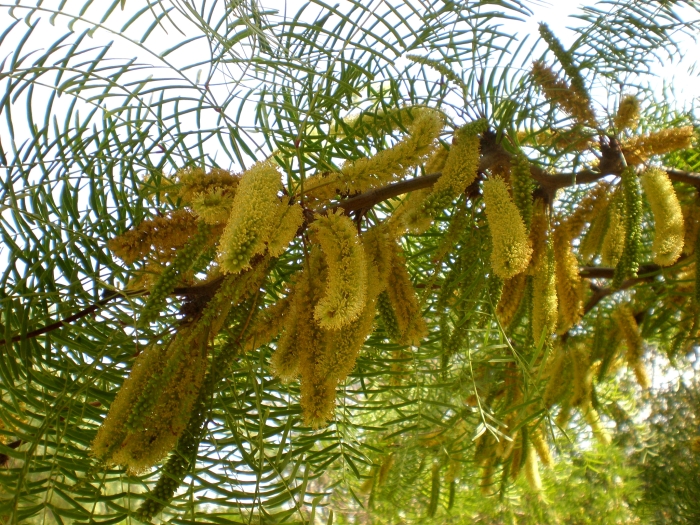Chilean Mesquite
(Prosopis chilensis)
Chilean Mesquite (Prosopis chilensis)
/
/

Consultaplantas
CC BY-SA 4.0
Image By:
Consultaplantas
Recorded By:
Copyright:
CC BY-SA 4.0
Copyright Notice:
Photo by: Consultaplantas | License Type: CC BY-SA 4.0 | License URL: https://creativecommons.org/licenses/by-sa/4.0 | Uploader: Consultaplantas | Publisher: Wikimedia Commons | Title: Prosopis_chilensis_4c.JPG | Notes: User created page with UploadWizard |

























Estimated Native Range
Summary
Prosopis chilensis, commonly known as Chilean Mesquite, is a semi-deciduous tree native to the dry forests and scrublands of South America, particularly in Chile and Argentina. It typically reaches a height of about 14 meters (46 feet) with a stout and gnarled trunk that can measure up to a meter (yard) in diameter. The bark is pale brown, thick, and characterized by cracks and vertical fissures. The foliage consists of bipinnate leaves that provide dappled shade. Chilean Mesquite produces dense axillary spikes of flowers, each with five sepals, five petals, and ten stamens. The flowers are yellow and bloom between October and December, offering a modest display. The fruits are distinctive twisted or coiled pods up to 15 cm (6 in) long, containing several coffee-colored seeds, and ripen between February and April.
Chilean Mesquite is valued for its hardiness and adaptability to arid environments, making it suitable for xeriscaping. It is often used for shade in urban settings, as a windbreak, and for erosion control. In cultivation, it requires minimal water once established and thrives in well-drained soils, tolerating a range of soil types from sandy to clay. It prefers full sun but can tolerate some shade. While it is drought-tolerant, it can also withstand occasional flooding. Gardeners should be aware that its deep root system can be aggressive, potentially damaging sidewalks and foundations. Additionally, Prosopis chilensis is potentially invasive outside its native range, and its thorns can be a nuisance. Before planting, check local regulations and consider its potential to spread.CC BY-SA 4.0
Chilean Mesquite is valued for its hardiness and adaptability to arid environments, making it suitable for xeriscaping. It is often used for shade in urban settings, as a windbreak, and for erosion control. In cultivation, it requires minimal water once established and thrives in well-drained soils, tolerating a range of soil types from sandy to clay. It prefers full sun but can tolerate some shade. While it is drought-tolerant, it can also withstand occasional flooding. Gardeners should be aware that its deep root system can be aggressive, potentially damaging sidewalks and foundations. Additionally, Prosopis chilensis is potentially invasive outside its native range, and its thorns can be a nuisance. Before planting, check local regulations and consider its potential to spread.CC BY-SA 4.0
Plant Description
- Plant Type: Tree
- Height: 20-30 feet
- Width: 30-40 feet
- Growth Rate: Moderate
- Flower Color: Yellow
- Flowering Season: Spring, Summer
- Leaf Retention: Semi-Deciduous
Growth Requirements
- Sun: Full Sun
- Water: Low
- Drainage: Medium, Fast
Common Uses
Bank Stabilization, Bee Garden, Bird Garden, Butterfly Garden, Drought Tolerant, Edible*Disclaimer: Easyscape's listed plant edibility is for informational use. Always verify the safety and proper identification of any plant before consumption., Low Maintenance, Street Planting
Natural Habitat
Native to the dry forests and scrublands of South America, particularly in Chile and Argentina
Other Names
Common Names: Chilean Algarrobo, Algarrobo, Algarrobo Blanco, Algarrobo De Chile, Mesquite, Kabuli Kikkar, Vilayati Babul, Vilayati Khejra, Vilayati Kikkar, Kiawe
Scientific Names: , Prosopis chilensis, Ceratonia chilensis,
GBIF Accepted Name: Prosopis chilensis (Molina) Stuntz